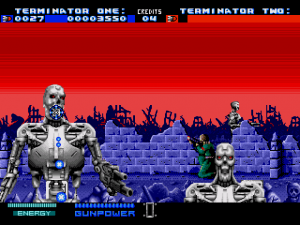

Meanwhile, on the home front, a few more light guns had cropped up. The game got a sequel a few years later in The House of the Dead 2, most fondly remembered for its godawful voice acting.
#Lethal enforcers 2 gunfighters sounds series#
Ironically, series director Takashi Oda insists that the enemies in The House of the Dead aren’t zombies, but are “creatures” due to how they are all made scientifically instead of passing along the infection through bites. It also introduced fast-running zombies, which many zombie films in the 2000s then used. The game’s final boss flies around and shoots fireballs at youīesides influencing future light gun games, The House of the Dead also re-popularized zombies in wider media alongside Resident Evil.


So much so, in fact, that the game was given an option to change the blood colour in development, as Sega AM1 anticipated that it would inevitably be censored abroad. The House of the Dead broke the mould with an abundance of graphic violence. While Time Crisis and Virtua Cop both had you killing scores of enemies, there wasn’t any blood or gory elements. The gore was, undoubtedly, the most standout part of the game at the time. The House of the Dead‘s creatures explode in blood and viscera depending on which body part you shoot Sega built on Virtua Cop’s positional damage system with gory chunks now blasting out of wherever you hit on zombies. Developed in the Virtua Cop engine, The House of the Dead similarly was on-rails with players dispatching enemies as they appeared, this time with a horror coat of paint and zombies galore. Time Crisis starts off blazing fast and doesn’t slow down until you fire your final shotĪbsolute beast and one-man army Richard Miller can easily save the day in 9 minutes The House of the Deadīack at Sega, they had begun development on their next light gun game, The House of the Dead. In Time Crisis, though, you could actually defend yourself against gunshots with strategic use of cover instead of just admiring the barrel of the bad guys’ guns. In previous arcade games, the most you could do to avoid damage was either shoot down projectiles or kill the enemy before they hit you. The arcade cabinet had a pedal that the player had to hold down to pop out of cover. The main new feature of Time Crisis was a cover system. In 1995, a year after Virtua Cop, Namco released Time Crisis, a game that took Sega’s cop-shooter and expand upon it. Some games, however, expanded on this format to give some agency to the player. Namely, the on-rails traversal of areas is still at the core of arcade shooters. While at times the game expects pinpoint accuracy and near-perfect reactions, it paved the way for future light gun titles. Virtua Cop also gave us the perfect plan for if you’re in a hostage scenario: dive out of cover in front of armed police and yell “help me!” The game was also unique for how enemies reacted to getting shot, with different animations playing depending on where they get hit. Instead of sidescrolling 2D landscapes of targets, Virtua Cop saw you going through 3D areas with enemies popping out of cover to test your reflexes. It wasn’t until Sega‘s Virtua Cop in 1994 that they transitioned to a more dynamic style. The other thing that links these games is their difficulty much like many other arcade games at the time that sought to get as much money out of players as they could. Games like Midway‘s Terminator 2: Judgement Day and Konami‘s Lethal Enforcers featured digitized sprites on scrolling backdrops. Duck Hunt and Hogan’s Alley are both pretty simple gamesįor a while most of these games, both at home and in arcades, were shooting galleries. This also, unfortunately, means that these games are only playable on CRT monitors. This would get iterated on with later guns, but it’s a similar concept. The gun would then detect that light and register the shot if the player aimed correctly, hence the name “light gun”. To put it simply, on pulling the trigger, the screen would go black save for the target on screen, which would stay light. Mainly used for games like Duck Hunt and Hogan’s Alley, the Zapper shows generally how light guns would work throughout the majority of their existence. The light gun as a home console peripheral first appeared in the mid-1980s with Nintendo‘s NES Zapper. What I would say is a bit more of a loss, however, is the light gun. You mean I don’t have to shell out an extra fifty quid for a guitar to play my game? Goodness, how could I ever recover…? By and large, that’s not a staggering loss.


 0 kommentar(er)
0 kommentar(er)
